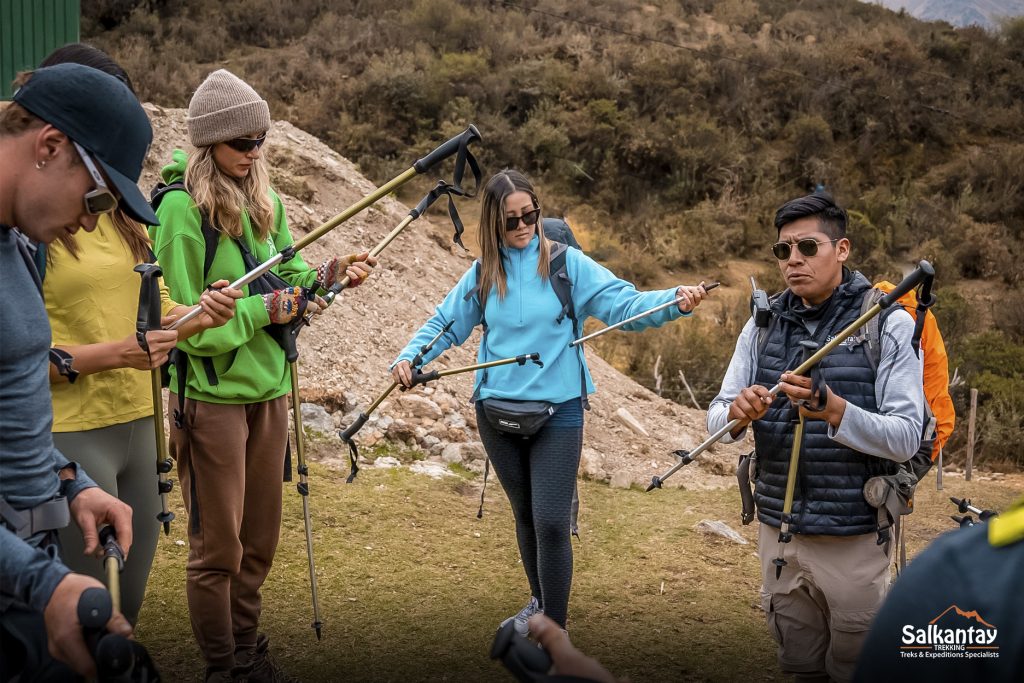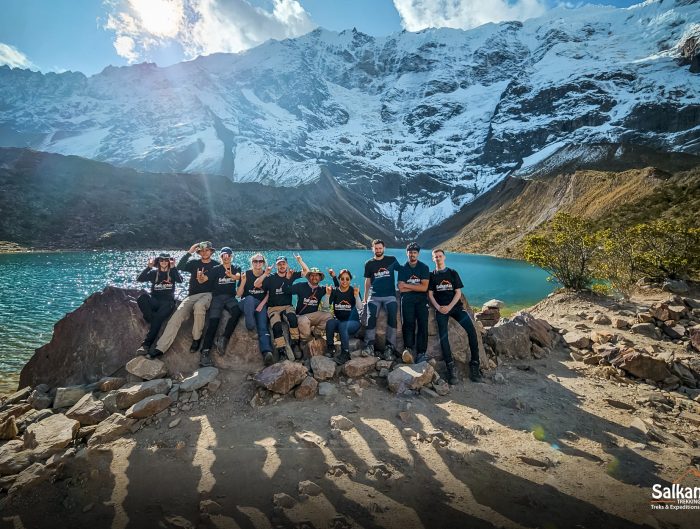Hello, mountain adventurers! If you’re passionate about trekking and looking to enhance your outdoor experience, you’ve come to the right place. This space is specially designed for you, where we will explore the fascinating world of trekking poles together.
Since ancient times, trekking poles have been loyal companions for walkers. It’s said that the first models were simply branches chosen for their strength and ergonomics. Over the centuries, this accessory has evolved, becoming an essential element for mountain lovers. Nowadays, trekking poles are made with advanced technology, designed to offer support, stability, and comfort with every step you take on your adventures.
Get ready to explore, learn, and, most importantly, enjoy nature with every step. Let’s begin this exciting adventure together!
What are trekking poles for?
Trekking poles are more than an optional accessory; they are your best allies when facing challenging mountain terrain. Designed to provide stability and balance and reduce the impact on your joints, these poles are crucial to making every hike a safer and more comfortable experience.
1. Stability on uneven terrain
Have you ever encountered terrain full of rocks, uneven surfaces, or steep slopes? This is where trekking poles shine. They provide:
- Extra support.
- Allowing your feet to focus on the path while your arms help distribute the weight.
- Preventing slips and falls.
2. Reducing strain on joints
Knees and ankles are often the most affected during long hikes, especially on descents. Trekking poles can reduce pressure on these areas by up to 20%, helping to prevent long-term injuries. Every step becomes lighter and more manageable, allowing you to enjoy the surroundings without worrying about accumulated fatigue.
3. Better posture and increased endurance
Proper posture is essential in trekking, and poles help you achieve this. Walking upright with active arms makes you feel more balanced and distributes the effort between your legs and arms, increasing your endurance on long, demanding routes.
4. Assistance on ascents and descents
When facing steep climbs, trekking poles allow you to push yourself forward more efficiently by using the strength of your arms. They act as natural brakes on the descent, giving you more control over your pace and preventing gravity from working against you.
5. Support for crossing water and snow
If your route involves crossing streams, rivers, or snowy areas, trekking poles offer extra support, helping you maintain balance on slippery surfaces. They can also help test the depth of a puddle or the stability of the terrain before proceeding.
Trekking poles enhance your mountain experience and are essential to optimize your performance and safety. Whether walking a simple trail or climbing a challenging mountain, these companions will make you feel safer, more comfortable, and better prepared for any obstacles you encounter on your adventure.


Benefits of Using Trekking Poles
Trekking poles are not just essential tools for mountain adventurers; they also offer a range of critical benefits that improve your performance, safety, and enjoyment during any hike. Here is an expanded list of the most notable benefits:
1. Performance improvement
Trekking poles efficiently distribute your body weight, relieving the load on your legs. This reduces the impact on your joints, especially your knees and ankles, which is crucial during steep descents or long hikes. Additionally, using the poles, you engage your upper body muscles, such as shoulders and arms, creating a more balanced walk and increasing your physical endurance.
2. Injury prevention
Injuries are common in outdoor activities, but trekking poles can be your best defense against sprains, ankle twists, and muscle pains. By offering additional support, poles reduce the chance of your feet moving unsafely on uneven terrain. They also help maintain better posture, reducing strain on your lower back and hips. If you’re walking long distances with a backpack, the poles prevent premature muscle fatigue and balance the effort throughout your body.
3. Increased safety
Trekking poles allow you to move confidently, preventing falls and ensuring a steady step in adverse weather conditions such as rain, mud, or snow. They can also be helpful in probing unstable terrain or crossing small streams.
4. Reduced fatigue
By distributing the effort between your legs and arms, the load eases muscle fatigue and helps you maintain a steady pace without overstraining your legs. This helps you save energy.
5. Improved balance and posture
On rocky or uneven terrain, trekking poles provide a “third point of support,” reducing the risk of losing balance. They also encourage more aligned walking, preventing the slouching that can lead to back or hip pain.
6. Increased speed and efficiency
You can use your arms to gain speed when you lean on them, especially during ascents. On descents, the poles act as natural brakes, giving you more control over your pace without straining your joints.
7. More versatile exploration
With trekking poles, you can venture into more varied terrain, from easy trails to routes with natural obstacles such as rivers, streams, or snowy areas. In addition to helping with balance and stability, the poles allow you to explore more challenging environments, such as soft snow areas, muddy ground, or steep slopes. They can even push aside small branches or animals, making them a multifunctional accessory.
8. Adaptation to different heights and terrains
The adjustable height of many trekking poles allows them to be adapted to different terrains and conditions. If you’re climbing a mountain, you can shorten the poles to help push upward. On descents, you can lengthen them so they act as support. This flexibility improves your performance on each terrain type, optimizing your effort.
Trekking Pole Walking Techniques
Mastering trekking poles maximizes their benefits and allows you to enjoy a safer and more efficient hike. Here are the essential techniques to get the most out of your poles.
1. Correct posture
Maintaining proper posture while walking with trekking poles is essential to ensure balance and avoid injuries. Here are the key points to achieve this:
- Straight back and eyes forward: Walking hunched over can cause discomfort in your lower back and neck. Keep your back straight, and your shoulders relaxed. Always look ahead, not at the ground, to anticipate obstacles.
- Slightly bent elbows: Adjust the length of the poles so that your elbows are at a 90-degree angle when holding them. This allows you to move smoothly without straining your wrists or shoulders.
- Synchronized movement: As you walk, move the pole opposite to the leg you’re stepping forward with, i.e., the right leg with the left pole and vice versa. This promotes balance and prevents all the weight from resting solely on your legs.
2. Use on different terrains
Each terrain type requires adjusting your technique to optimize the use of the poles. Here’s how to do it in various situations:
- Ascents: On uphill climbs, shorten the poles to maintain a better push angle. Plant them slightly in front of you and use the strength of your arms to propel yourself upward, distributing the effort between your arms and legs.
- Descents: On descents, lengthen the poles to act as a natural brake and give you more stability. Place the poles in front of you, slightly angled downward, to reduce pressure on your knees and better control your speed.
- Uneven or rocky terrain: Using the poles as a “third point of support on trails with loose stones or unstable terrain.” Move slowly and ensure the pole is firmly planted before leaning on it, especially on slippery or sloping surfaces.
- Water or snow crossings: If you’re crossing a stream or a snowy area, plant the poles more firmly to test the terrain’s stability before each step. This way, you avoid slips or surprises with the water’s or snow’s depth.
3. Specific exercises for walking with poles
To maximize the benefits of trekking poles, it’s essential to strengthen the muscles involved in their use. These exercises will help you improve your endurance and technique:
- Arm strengthening: Do arm push-ups or light weightlifting (1-2 kg) to strengthen biceps and triceps. This will help you bear the weight of the poles during long hikes without tiring.
- Core work: A strong core (abdominal and lower back muscles) is critical to maintaining an upright posture. Exercises like planks, crunches, and the “Superman” (simultaneous lifting arms and legs while lying face down) will give you central stability and strength.
- Leg training: Squats, lunges, and lateral jumps are excellent for strengthening thighs and glutes, helping your legs better endure the effort on steep terrain.
- Cardiovascular endurance: Practice short walks or runs with the poles on varied terrain to get used to the coordinated movement and improve your aerobic endurance.
Mastering these trekking pole techniques will improve your performance and allow you to enjoy a safer and more pleasant mountain experience. With the correct posture, adapting your technique to different terrains, and avoiding the most common mistakes, you’ll be ready to tackle any trail with confidence and ease. Let the adventure begin!

Common Mistakes When Using Trekking Poles and How to Avoid Them
Even experienced hikers can make mistakes when using trekking poles. Here are the most common ones and how to correct them:
- Poles that are too long or too short: Incorrectly adjusting the pole length can lead to poor posture or excessive strain on your arms and shoulders. Remember that your elbows should be 90 degrees on flat terrain, and adjust the poles depending on the incline (shorter for uphill, longer for downhill).
- Relying too much on the poles: Poles are there to assist you, but they should only bear your portion of your weight. Using them as your sole support can create unnecessary strain on your wrists. Use them to complement your balance, only to depend partially on them.
- Not synchronizing movement: Moving the pole and the leg on the same side simultaneously can throw off your balance and cause you to stumble. Ensure you coordinate your movements correctly: right leg with left pole and vice versa.
- Forgetting to use the straps: The straps on trekking poles aren’t just for decoration; they distribute weight and relieve pressure from your hands. Wear them properly: pass your hand through the strap from below and then grip the handle. This will give you more control and reduce hand strain.
Trekking Pole Maintenance and Repair
If you take good care of your trekking poles, they will be your companions on many adventures. Keeping them in optimal condition will prolong their lifespan and ensure they work correctly at all times, from easy walks to the most challenging trails. Here’s a guide on cleaning, repairing, and storing them so they’re always ready for your next hike.

1 Cleaning and Lubrication
One essential step to keeping your poles in good condition is regularly cleaning and lubricating them. Dirt and dust buildup can affect their performance, especially in the adjustment and locking mechanisms.
- Cleaning after each use: Clean the poles after a hike, especially in muddy, snowy, or sandy conditions. Use a damp cloth to remove mud and dust from the pole sections. Pay special attention to the telescopic or adjustment joints, where particles can accumulate and cause wear.
- Proper drying: After cleaning, it’s essential to dry the poles thoroughly to prevent rust on metal parts, such as the tips or locking mechanisms. If exposed to water, disassemble the telescopic sections and let them dry completely before storing.
- Lubricating the mechanisms: To ensure the locking mechanisms (whether twist or clip) work smoothly, it’s advisable to lubricate them occasionally. Use a light lubricant, such as silicone oil, and apply a small amount to the moving parts. This will prevent them from sticking or wearing out due to constant use.
2 Repairing Common Issues
Trekking poles are built to withstand a lot, but you might face minor issues on a challenging hike. Here’s how to repair the most common problems so you don’t have to buy a new pair whenever an issue arises.
- Broken sections: If one of the pole sections breaks, several solutions exist. You can temporarily fix the broken section with high-strength tape (like duct tape). If the break is significant, replacing the damaged section is best, which is usually more affordable than buying a new pole. Many manufacturers offer replacement parts, so check if yours does.
- Locking mechanism failures: The locking mechanism may be faulty if the telescopic poles don’t adjust or come loose quickly. First, disassemble the affected section and thoroughly clean the internal parts, as dust buildup could be the cause. If the mechanism still doesn’t work, check if it’s worn out or broken. Repair or replacement kits for locking mechanisms are available at specialized stores and are easy to install.
- Worn tips: The poles’ tips are most susceptible to wear, especially if you walk on rocky terrain. If you notice that the metal tips are worn down or the rubber tips are almost smooth, it’s time to replace them. Most models allow you to change the tips easily, and replacements can be purchased at outdoor gear stores.
3 Storage Tips
Proper storage is critical to keeping your trekking poles in perfect condition between hikes. Improper storage could lead to rusted parts, stuck mechanisms, or deformed sections the next time you need them.
- Store dry and clean: Only store the poles after cleaning or when wet. Water trapped in the telescopic joints can cause rust or malfunction. Make sure they are scorched before storing them.
- Disassemble and loosen sections: If your poles are telescopic, it’s a good idea to loosen the sections before storing them. Storing them fully extended can pressure the adjustment mechanisms and cause premature wear. Disassemble the sections or store them at their minimum length to avoid deformation.
- Protect the tips: If the metal tips don’t have rubber caps, it’s a good idea to protect them before storing the poles. This will prevent the tips from damaging other trekking gear and prevent unnecessary wear.
- Store in a cool, dry place: Avoid leaving poles in extremely hot or humid places, such as inside a car or basement. Extreme heat can deform rubber or plastic parts, while humidity can rust metal components.
Maintaining and repairing your trekking poles properly ensures they’re ready for every new adventure without unexpected failures. With these simple steps, you’ll extend their lifespan and enjoy the stability and comfort they provide for much longer. Take care of them as they take care of you on every trail!













Leave A Reply